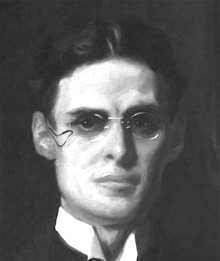
Edwin Alfred Rickards [also known as E.A. Rickards] has been described as the most flamboyant of the Edwaedian architects. He was born in Chelsea, London, England in June 1872 and was articled to Richard John Lovell (1858?-1931) at the age of fifteen in 1887. He also studied the Royal Academy Schools in London and attended classes at the Architectural Association in London. From 1889 he was employed as an assistant to Frederick Eedle and Sydney Herbert Meyers (1865-?) of Eedle & Meyers; to William Dunn (1859-1934) and Robert Watson (1865-1916) of Dunn & Watson; to James Howard Ince; to George Campbell Sherrin (1843-1909); and to Leonard Aloysius Scott Stokes (1858-1925). In 1896 he qualified as an architect and that year went into partnership with Henry Vaughan Lanchester (1863-1953) and with James A. Stewart (1860-1904) in the London-based architectural firm Lanchester, Stewart & Rickards. Following the death of Stewart in 1904, the practice was renamed Lanchester & Rickards.
Rickards was elected a member of the Art Workers Guild in 1904 and a Fellow of the Royal Institute of British Architects (FRIBA) in 1906. In addition to his work as an architect and sculptor, Rickards was a painter and illustrator. A watercolour sketch of St. John Evangelist Church in Red Lion Square, London, by him is illustrated in Architectural Review vol.1 no.1, November 1897 (p.8). Rickards illustrated Paris Nights (1913) and From the Log of the Velsa (1914) by Arnold Bennett. He also designed the cover of the Royal Institute of Town Planning Conference, 1910: Members' Handbook.
In 1916 he volunteered for service in World War One but was invalided out of the Army within three months. He died in Bournemouth, Dorset on 28 August 1920.
Architectural projects by Lanchester, Stewart & Rickards included Cardiff City Hall and Law Courts (1897); Deptford Town Hall, south London (1903).
Architectural projects by Lanchester & Rickards included Cardiff City Hall and Law Courts, Cardiff (1897-1906); Flats, Handel Street, Bloomsbury, London (1898); Deptford Town Hall, New Cross Road, Lewisham, London (1902-04); Hull School of Art, Anlaby Road, Hull, Yorkshire (1902-04); The Wesleyan Central Convocation Hall, London (1905-11); Public fountain and Edward VII Memorial, Bristol (1907-13); Third Church of Christ Scientist, Curzon Street, London (1910–13); Knoedler's, 14 Old Bond Street, Mayfair, London; Colnaghi's Art Gallery, 144–147 New Bond Street, London (1911-13).
Rickards designed a number of public ornaments, including the Lord Roberts Monument in Calcutta (1894-98) in collaboration with Harry Bates (1850-1899). He also collaborated with the sculptor Henry Poole (1873-1928) on public monuments including the statue of Captain Albert Ball for Nottingham Castle, unveiled on 8 September 1921.
The Art of E. A. Rickard, comprising a collection of his architectural drawings, Paintings, and Sketches with a Personal sketch by Arnold Bennett, an appreciation by H. V. Lanchester and technical notes by Amor Fenn. London: Technical Journals Ltd., 1920.
Brittain-Catlin, Timothy. Edwin Alfred Rickards. Liverpool: Liverpool University Press, 2023
Directory of British Architects 1834-1914. Compiled by Antonia Brodie, et al. Volume 2: L-Z. London; New York: British Architectural Library, Royal Institute of British Architects/Continuum, 2001
'Edwin Alfred Rickards, 1872 - 29 Aug. 1920'. RIBA Journal 25 September 1920, pp. 470-473
Gray, A. Stuart. Edwardian architecture: a biographical dictionary. London: Gerald Duckworth & Co., Ltd., 1985
Howell, Peter. ‘The decoration of Brompton Oratory Church 1928-32.‘ Ancient Monuments Society. Transactions vol. 59, 2015, pp. 39-47. [Discusses the decoration of Brompton Oratory by George Sherrin and Edwin Rickards in 1928-31]
'Obituary'. Architectural Review vol. 48, October 1920 pp. 100-101
'Obituary'. The Builder vol. 119, 1920 p. 247
Warren, John. 'Edwin Alfred Rickards' in Edwardian Architecture and its Origins. Edited by Alastair Service. London: The Architectural Press Limited, 1975 pp. 339-350]
Who’s Who in Architecture 1914. London: Yechnical Journals Ltd., 1914